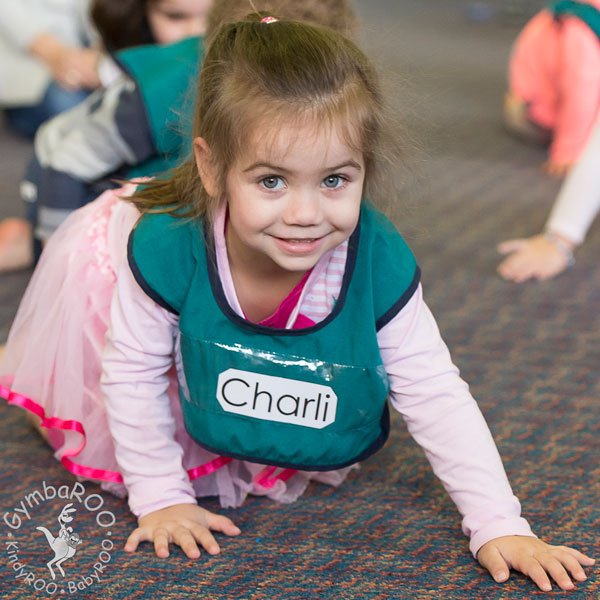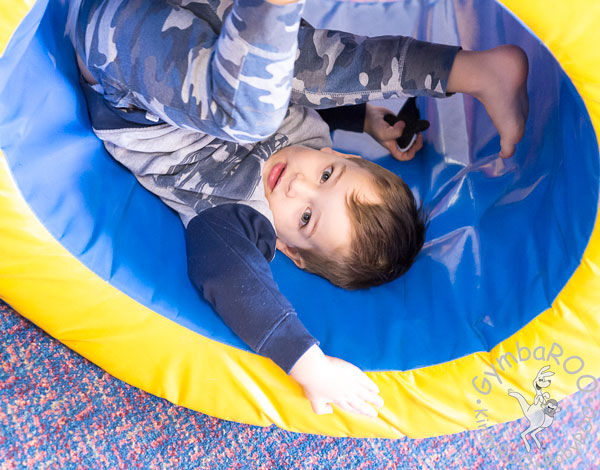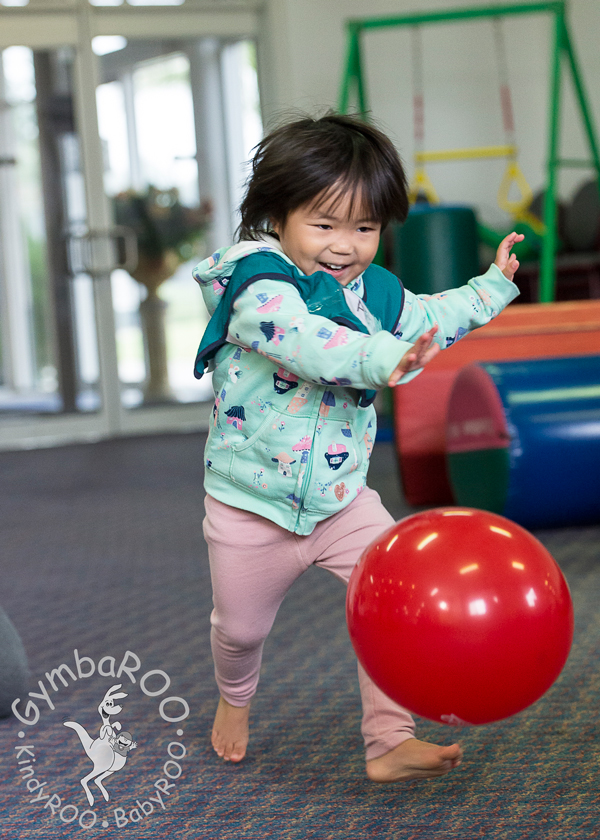Join the thousands of parents already raising smarter, happier babies with our online baby classes: The Active Babies Smart Kids series. Click here.
GymbaROO-KindyROO kids are excelling academically, emotionally, in leadership roles and on the sporting field. Find us at: GymbaROO-KindyROO
Dr Jane Williams and Bindy Cummings
Researchers are concerned that growing numbers of children are starting school uncertain whether they are right- or left-handed and that this is hindering their academic and physical development. Why is this happening and does it matter?
There is a lot of discussion regarding the attainment of a preferred hand or ‘handedness’ and school readiness. In the first couple of years of life, both sides of the body need to be equally well developed and you will notice that special attention is paid to this at GymbaROO. However, by the age of 3 ½ , the majority of children should have attained a preferred hand. Researchers have noticed that children who attend school without a preferred hand, may find learning more challenging than a child who has a preferred hand.
Handedness is linked to the development of the brain. The larger part of the brain is divided into two hemispheres, left and right. In the third year of life, one hemisphere appears to take a leading, or ‘categorical’ role and becomes specialised for categorical functions, for example; language skill development, reading, writing and mathematical-based skills. The other hemisphere becomes specialised in spatiotemporal relations, such as; the recognition of faces, the identification of objects by their form and the recognising of musical themes.
Neither hemisphere operates in isolation from the other and there is a lot of ‘crossing over’ of information between the two. In right-handed individuals the left hemisphere is the categorical hemisphere. In approximately 30% of left-handed people, the right hemisphere is also the categorical hemisphere. The categorical side influences which side of the body will be preferred for holding implements (handedness), kicking, listening and seeing. The process of hemispherical specialisation is called ‘lateralisation’. It is only if the child has had plenty of sensory and motor experiences as an infant and toddler, enabling them to develop both sides of the body equally, that the brain can properly mature and can smoothly lateralise. This is why, in most cases, babies and toddlers should not be right- or left-handed! It is through the process of lateralisation that children will develop a preferred hand, foot and eye.
If your child is approaching school age and has not yet developed a preferred hand, it may be a result of genetics, but it may also be due to a developmental immaturity. While this has nothing to do with your child’s intelligence, it can be a nuisance and a disadvantage when your child goes to school.
Children who start school without a preferred hand often have difficulty crossing their midline and will tend to pick up an object with their left hand if it is on their left side and with their right hand if it is on their right. They may be confused about which hand to write with and are inclined to mirror others, that is, if sitting opposite a right-hander they will use their left. Reversals are a common difficulty for many of these children and they can struggle with which way letters and numbers go. They may be ‘clumsy’ in their movements and have trouble with balance, coordination, throwing, catching and kicking skills.
For some children, arriving at school without a preferred hand will not matter, however we advise that it is better to err on the side of caution than to take the ‘wait and see’ policy. If you are concerned about your child, ask your GymbaROO teacher for guidance.
How can I assist my child to develop a preferred hand?
Activities that best assist in the development of a preferred hand are those that stimulate and help mature the brain pathways. Importantly many of these activities need to focus more on whole body movements and actions, rather than just on the hand.
- Crawling on the tummy and creeping on the hands and knees helps to stimulate both sides of the body through the senses of touch and movement of the muscles and joints. This helps the brain ‘learn’ that there are two sides to the body. It also stimulates the hands as they pull along on the floor while tummy crawling or slap down on the ground while creeping. For older children, imitating animals is terrific for this!

- Lots of massage and exercise, especially those you learn at GymbaROO!
- Movement that involves spinning, rolling, tumbling and dancing stimulates the balance organs in the brain. These organs play an important role in telling the brain where the body is in space and what movements are necessary for posture, response to stimuli and action. Children need good balance and coordination for healthy brain maturation and the development of handedness.

- When playing with your child, let them know which hand they are using i.e. “This is your right hand.” “I am tickling your left hand.” “Let’s put on your right sock.”
- Clapping and clapping games are a fun way to stimulate the sensory endings in the hands, letting the brain know where the hands are, how they feel and what they do. Stamping feet or clapping them together while sitting, sends messages to the brain about those distant, but important parts of the body.
- As your child gets older and can manipulate his or her fingers individually, engage in hand play and finger games. Read more: Fingerplays and action rhymes: So many benefits! Activities for 0 – 5 year olds.
- Do fun exercises that get the body moving the same way on both sides. For example, Angels in the Sand can be done with ‘homolateral’ movements (each side does the same thing). Once your child can do these successfully and repetitively, introduce cross-lateral movements i.e. the left leg moves out while the right leg bends, the right arm bends and the left arm straightens. You can do these exercises lying on the floor or standing upright.
Dr Jane Williams (PhD, BMgt, RN(Paeds)) is the Research and Education General Manager for GymbaROO and KindyROO. Dr Williams is one of Australia’s leading experts on baby and child development. More on Dr Williams here.
Bindy Cummings (B.Ed(Human Movement) Hons) has worked as a teacher, child development consultant, early childhood development lecturer, teacher trainer and INPP & iLS consultant. She is the co-creator of GymbaROO’s Active Babies Smart Kids online series, has authored many published articles on child development. She is working on the content and development GymbaROO’s portal and online training programs, and the creation of new online programs for parents and children. More on Bindy Cummings here.
GymbaROO Images by Studio Z Photography
GymbaROO-KindyROO
Thousands of parents, babies and children are presently involved in our programs and creating rising stars. GymbaROO-KindyROO kids are excelling academically, emotionally, in leadership roles and on the sporting field. Come join all the fun and learning! “GymbaROO – The best decision I ever made for my child.” Classes from 6 weeks old – 7 years GymbaROO KindyROO
Active Babies Smart Kids – Online Baby Classes
GymbaROO-KindyROO’s online series of baby classes is taking the parenting world by storm! It is highly recommended by doctors, paediatricians, early childhood experts and the Maternal Child and Family Health Nurses Association. This series is being called: “The essential guide for parents”. Join the thousands of parents already playing with their babies from birth, in the best way for brain and body development and laying crucial foundations for future learning. What happens in the first year, not only matters, it matters a lot! Enjoy the introductory video below.
Click here: Active Babies Smart Kids online series
Try the first episode FREE: Tummy time + baby fun and development class 1
Enjoy the following GymbaROO-KindyROO articles
GymbaROO-KindyROO: Who, what, where, why and how
All about GymbaROO-KindyROO’s online baby classes for parents and babies: Active Babies Smart Kids
How to raise a smarter, happier baby
School Readiness: Is my child ready for school? A checklist
Seven Primary School Captains in 2016 from one GymbaROO babies class in 2005.
Expert’s 10 golden rules for raising happy, successful children.
When will my baby / toddler become right or left handed?
Click here for more GymbaROO-KindyROO article choices.




